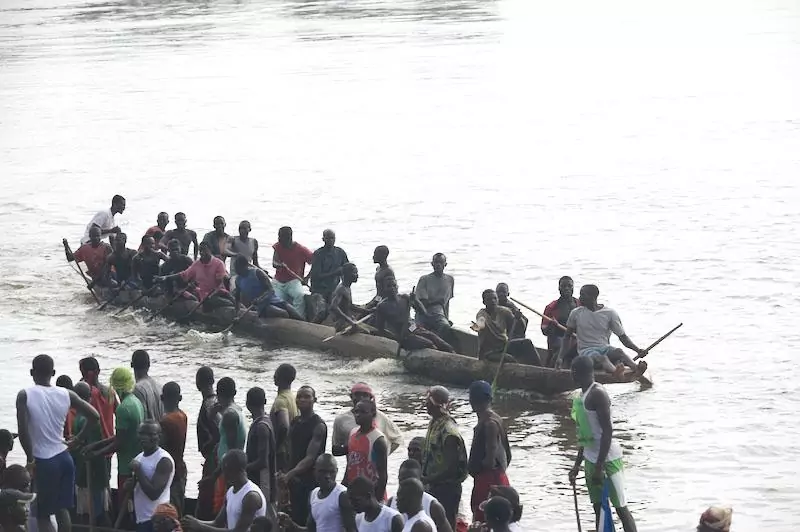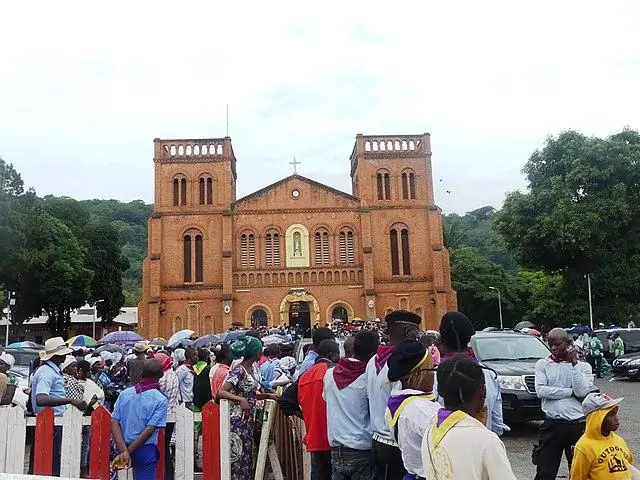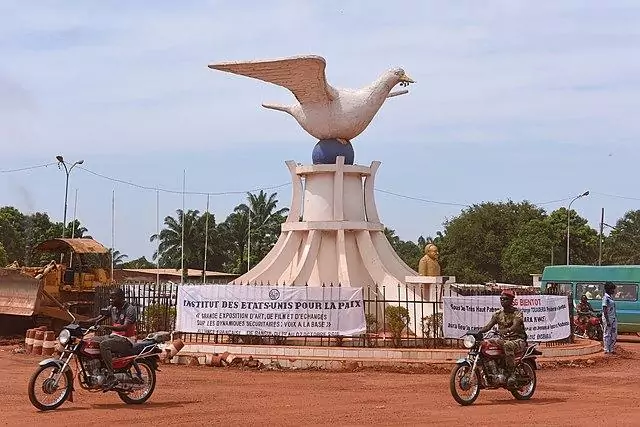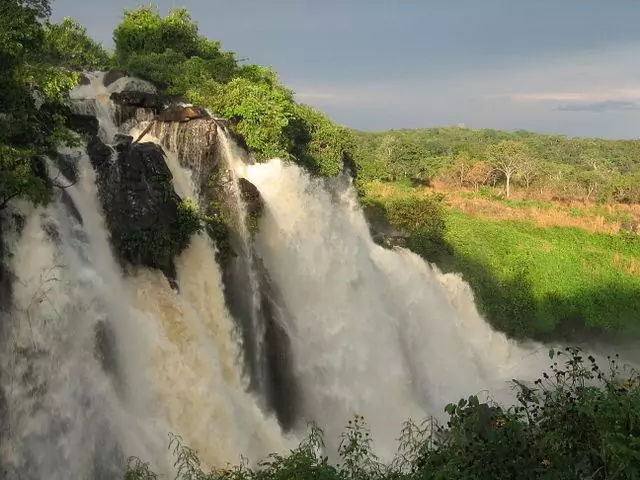
Violent criminal gangs, rebel groups and a host of tropical diseases make the Central African Republic one of the world’s most dangerous countries to visit. With most nations issuing travel warnings, its notorious reputation has made the CAR the last frontier for ultra-intrepid travelers. Nestled along the Ubangi River, the country’s capital, Bangui, has developed in a matter of a few decades into a sprawling metropolis, where the CAR’s political and economic center lies. Despite its troublesome past and present, the city is home to a myriad of interesting sites and sceneries to explore, completely unspoiled by mass-tourism and over-commercialism.
It is difficult to overstate the sheer importance of the Ubangi River to the city of Bangui, and to a larger extent the entire country. Straddles the border between the Central African Republic and the Democratic Republic of the Congo, the river is an important trade route where much of the country’s exports and imports goes through as it ultimately merges with the Congo River. In fact, Bangui is the last major population center before the river becomes unnavigable due to the rapids further upstream, a geographical feature which the city owes its name to (Bangui is the term for rapids in the local Bobangi language).
As the city copes with the lack of proper infrastructure, don’t expect anything that looks remotely like a well-kept promenade. Nevertheless, in spite of its dingy appearance, the riverfront is brimming with incredible sights, most notably a constant traffic of wooden canoes that culminates several times a year during the city’s massive boat races. A couple of fishermen along the riverbank offer a short boat ride for tourists, though take note that some of whom illegally cross the international border into neighboring DRC.
Perhaps the riverfront’s most appealing aspect is a series of bars and restaurants that overlook the river and its hectic vessel traffic. The vast majority of the dining options is concentrated between Rue du Kassai and Boulevard du Générale de Gaulle, including La Tourangelle, famous for its riverside balcony and Restaurant de l’Oubangui, located on a tip of a small headland that stretches deep into the gushing waters.

A boat race along the Ubangi River’s segment of Bangui
photography by: Afrika Force/ Wikimedia Commons
First introduced by the French Colonial Rule, Christianity is now overwhelmingly the country’s predominant religion, with roughly 90% of its 4.83 million residents being Christians. While outnumbered by Protestants by two to one, over 1.5 million people are adherents of Catholicism, making it an influential force amid the CAR’s cultural landscape.
Completed in 1937, the Notre-Dame of Bangui Cathedral serves as the seat of the Archdiocese of Bangui, the sole one throughout the country. As its name implies, the cathedral was inspired by its famous Parisian counterpart, both architecturally and religiously. The red brick building features a lavish three doorway façade sandwiched by a pair of symmetrically aligned towers. The church’s magnificent nave culminates around the altar, where a large crucifix is beautifully lit by four colorful windows.
Like the rest of this nascent nation, the cathedral didn’t manage to dodge its perpetual ethnic and religious conflicts. In 2014, the church was attacked by the Seleka militia (often dubbed as Muslim rebels), claiming the lives of 15 people including a local priest. A year later, Pope Francis visited the cathedral where he encouraged all religious groups in the country to coexist in spite of their deep hostility towards each other.

A throng of worshipers in front of Notre-Dame of Bangui Cathedral
photography by: Freeman Sipila (VOA)/ Wikimedia Commons
As ludicrous as it might sound, Bangui was modeled after a typical French city, with grand boulevards, roundabouts and even its own Arc de Triomphe. While its gritty and chaotic nature is as far as possible from the tidy streets of the French capital, both cities have far more in common than one initially assumes.
In first glance, Bangui’s main square seems like everything you would expect from an African city, hectic, teeming with people and moderately monumental. It is only its name, Point Kilomètre Zéro or simply PK0, which reveals its original intent. Put simply, this square is to Bangui what point zero of Paris is to the City of Lights, a reference point that supposedly stands for the city’s absolute center, from where distances to the rest of the country are measured in relation to.
Besides its intriguing moniker, the square with its well-kept lawns is an excellent location to have a glimpse of some of Bangui’s most important landmarks. One of the boulevards that culminates at the square, Av. Barthelemy Boganda, is embellished by a large arch honoring Jean-Bédel Bokassa, the country’s second president and self-proclaimed emperor.
If you stand at the middle of the square, you can spot the outlandish Presidential Palace. Built during the era of Bokassa, the grand-scale building somewhat embodies his figure, as the former leader was notoriously known for his oppressive regime, lavish lifestyle and perhaps most strikingly, his Napoleonic-style coronation ceremony.

Point Kilomètre Zéro alongside Bokassa Arch
photography by: Afrika Force/ Flickr
Similar to many markets of its kind across Africa, Bangui Central Market offers an authentic experience for the better and worse. Nestled in the heart of the city, in front of the aforementioned PK0, the bustling market has a plethora of vegetables, fruits, spices and even live chickens. Many of its stands have spilled over to the surrounding streets, far beyond of the official market building.
Alongside its ample food section, you can also find here artisanal furniture, jewelry items and all sorts of knickknacks, particularly hand-carved tribal masks sold for a bargain price.
The market’s incredibly unsterile scenery is not for the faint hearted, especially the ones with white garments that under the dusty conditions throughout the marketplace will catch a brownish hue in a matter of minutes. Additionally, beware of pickpocketing as the crowded labyrinth is a favorable location among local thieves.
Bangui has no shortage of squares or more accurately, roundabouts, as vehicular traffic along the city’s crossroads between its grand boulevards is mostly regulated by a circular road instead of traffic lights, partly due to budgetary constraints. As part of a beautification efforts that coincide with a lofty endeavor to consolidate a national identity, many of those circles were decorated with large-scale sculptures and monuments.
Located in the intersection of Koudoukou St. and Av. des Martyrs, at the city’s northern district, Place de la Reconciliation, aka Place Marabena, was just another mundane roundabout if it wasn’t for the flamboyant sculpture that was erected a couple of years ago. The statue depicts a dove with an olive branch in its beak, perching on a small sphere that lies on a conical pedestal. As its French title might suggest, the monument was erected in honor of former Gabonese president, Omar Bongo, whose reconciliation efforts helped alleviate some of the tensions between the country’s multiple ethnic groups. Interestingly, a similar sculpture, Colombe De La Paix, was created at a busy traffic circle in Togo’s capital, Lomé.

The dove monument at the Place de la Reconciliation, aka Place Marabena
photography by: U.S. Institute of Peace/ Wikimedia Commons
Despite its great deal of authenticity, Bangui is a frenetic place, whose hustle and bustle might require a respite after a few days. There is probably no better hideaway for this much-needed break than Chutes de Boali, a series of waterfalls about 100 kilometers northwest of the capital.
The natural gem is located just off the RN 1 highway, one of the country’s handful of paved roads that ultimately reaches Cameroon. Following a short drive along a dirt road that also traverses a nearby dusty village, you’ll come across the formidable waterfalls, best seen from a further downhill lookout.
Often dubbed as the Niagara Falls of the Central African Republic, the Boali Waterfalls are a whopping 250 meter wide and 50 meter tall. The incessant stream of rumbling waters is particularly strong during the rainy season (July to September). Whilst the falls form a natural pool downstream, its crocodile infested waters are not recommended for swimming.
The Chutes de Boali’s segment of Mbali River is also home to two hydroelectric plants, Boali 1 and Boali 2, both of which have a combined output of over 18.5 megawatts, enough to supply electricity to Bangui as well as additional 13 villages and towns.

Chutes de Boali at their fullest glory
photography by: The EITI/ Wikimedia Commons